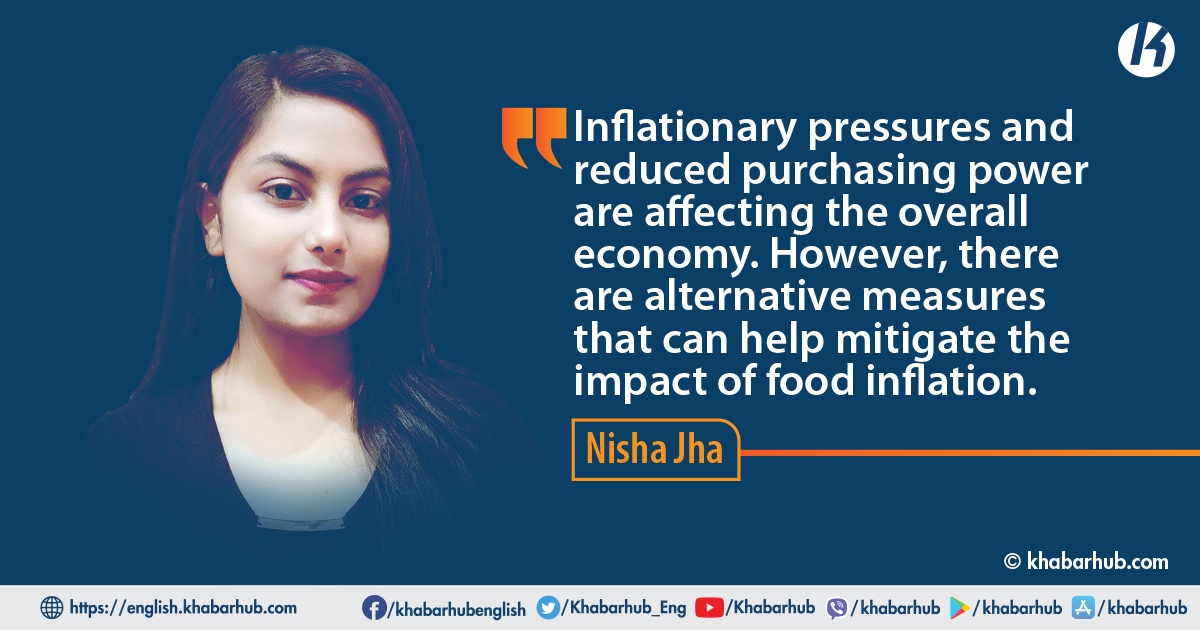Beware as food prices go soaring, putting a strain on your budget! The alarming surge in food costs is a burning issue that’s hard to ignore. Recent data from the Nepal Rastra Bank shocks with a staggering 5.54 percent increase in food prices during May 2023 compared to the previous year.
This relentless upward trend is hitting households hard, making it difficult for families to afford nutritious meals. As the situation intensifies, urgent action is required to tackle food inflation and ensure that everyone has access to affordable sustenance.
Food inflation refers to the persistent and concerning rise in food prices over time, which poses significant challenges to consumers and the economy as a whole.
There are various factors contributing to this problem, including imbalances in supply and demand, increasing production and distribution costs, fluctuations in global commodity prices, and disruptions in the supply chain.
Additionally, adverse weather conditions, government policies, and changes in consumer behavior can also play a role in driving up food prices.
The surge in food prices is reverberating through households, small businesses, and the broader economy, presenting significant challenges at multiple levels.
Encouraging agro ecological approaches, such as organic farming, precision agriculture, and water-efficient irrigation methods, can help conserve natural resources, reduce input costs for farmers, and ensure the long-term viability of the agricultural sector.
At the micro level, families are grappling with reduced purchasing power and the consequences of compromised diets.
As the cost of food continues to climb, households, especially those with limited financial resources, are finding it increasingly difficult to afford a well-rounded and nourishing diet.
Regrettably, this puts vulnerable groups, such as low-income families, at a higher risk of malnutrition and related health issues.
Moreover, rising food prices force families to redirect funds from other essential expenditures, intensifying existing socioeconomic inequalities.
The meso level is equally impacted, as small businesses and local economies bear the brunt of escalating food prices.
The mounting costs of inputs exert immense pressure on profit margins, leaving small-scale food producers and retailers in a vulnerable position.
In many cases, these businesses are forced to downsize their operations, lay off employees, or even face closure, leading to a loss of livelihoods within communities.
As consumers are compelled to prioritize meeting their basic food needs, sectors such as hospitality, entertainment, and retail experience a decline in sales, contributing to economic stagnation within local economies.
The macro level is not immune to the effects of food inflation, as it presents inflationary pressures and jeopardizes overall economic growth.
The sustained rise in food prices elevates the cost of living, reducing consumers’ purchasing power and disposable income.
This, in turn, has a dropping effect on various sectors of the economy, including manufacturing and services.
The strain of inflationary pressures also poses challenges for central banks and policymakers, who must navigate the delicate balance of maintaining price stability while fostering sustainable economic growth.
The effect of food inflation on tourism can be even more prominent. As food prices surge, it becomes challenging for tourists, particularly those on a tight budget, to afford meals and dining experiences.
This can lead to a reduction in discretionary spending on tourism activities, such as sightseeing, shopping, or engaging in local attractions.
Moreover, tourists may opt for cheaper alternatives or self-catering options, impacting local restaurants and food vendors who heavily rely on tourism-generated revenue.
The overall appeal of a destination’s culinary offerings may diminish if affordability becomes a concern, potentially leading to a decline in tourist arrivals and impacting the local economy dependent on the tourism sector.
As developing countries grapple with the challenges posed by rising food prices, there are alternative measures they can consider to preserve GDP and foster economic growth without exacerbating food inflation.
Recognizing the critical role of food as a basic necessity for all, these alternatives focus on improving food security and promoting sustainable agricultural practices.
One key strategy is to enhance agricultural productivity. Governments can invest in agricultural research and development, providing farmers with access to improved seeds, modern irrigation techniques, and advanced farming practices.
By increasing productivity, farmers can generate higher yields, contributing to a greater food supply and potentially stabilizing food prices.
This, in turn, ensures a more consistent food supply for the population and reduces the impact of price fluctuations on consumers.
Supporting smallholder farmers is another vital approach. Smallholder farmers play a significant role in the agricultural sector of developing countries.
By providing them with access to credit, technical assistance, and market linkages, governments can help enhance their productivity and resilience.
Additionally, investing in rural infrastructure, such as roads and storage facilities, can reduce post-harvest losses and improve market access.
These measures ensure fair prices for farmers and affordable food for consumers, while also boosting local economies by supporting rural livelihoods.
Diversifying agriculture is yet another effective strategy. By encouraging a shift towards a more diverse range of crops, countries can reduce their dependence on specific commodities that may be susceptible to price volatility.
This approach promotes a more balanced and resilient agricultural sector, where farmers have multiple income streams and consumers have access to a wider variety of affordable and nutritious food options.
Investments in agricultural value chains and agro-processing industries can also contribute to economic growth while addressing food inflation.
Developing countries can explore opportunities to add value to their agricultural produce through processing, packaging, and branding.
Enhancing agricultural productivity, supporting smallholder farmers, diversifying agriculture, investing in agricultural value chains, and promoting sustainable farming practices can be effective steps for developing countries, including Nepal, which has long suffered from inflation.
This not only helps increase the shelf life of perishable products but also creates employment opportunities and boosts exports, leading to economic development.
Lastly, promoting sustainable farming practices can have long-term benefits for both the economy and the environment.
Encouraging agro ecological approaches, such as organic farming, precision agriculture, and water-efficient irrigation methods, can help conserve natural resources, reduce input costs for farmers, and ensure the long-term viability of the agricultural sector.
The blistering impact of food inflation has sent shockwaves through households, small businesses, and the broader economy.
Families are struggling to afford nutritious meals, while small-scale food producers and local economies face mounting challenges.
Inflationary pressures and reduced purchasing power are affecting the overall economy. However, there are alternative measures that can help mitigate the impact of food inflation.
Enhancing agricultural productivity, supporting smallholder farmers, diversifying agriculture, investing in agricultural value chains, and promoting sustainable farming practices can be effective steps for developing countries, including Nepal, which has long suffered from inflation.
By implementing these strategies, a balance can be struck between ensuring food security and fostering economic growth.
These measures offer hope in tackling the flames of food inflation and ensuring that access to this fundamental necessity remains affordable for everyone.
(Writer is a student of Economics at Patan Multiple Campus)









Comment